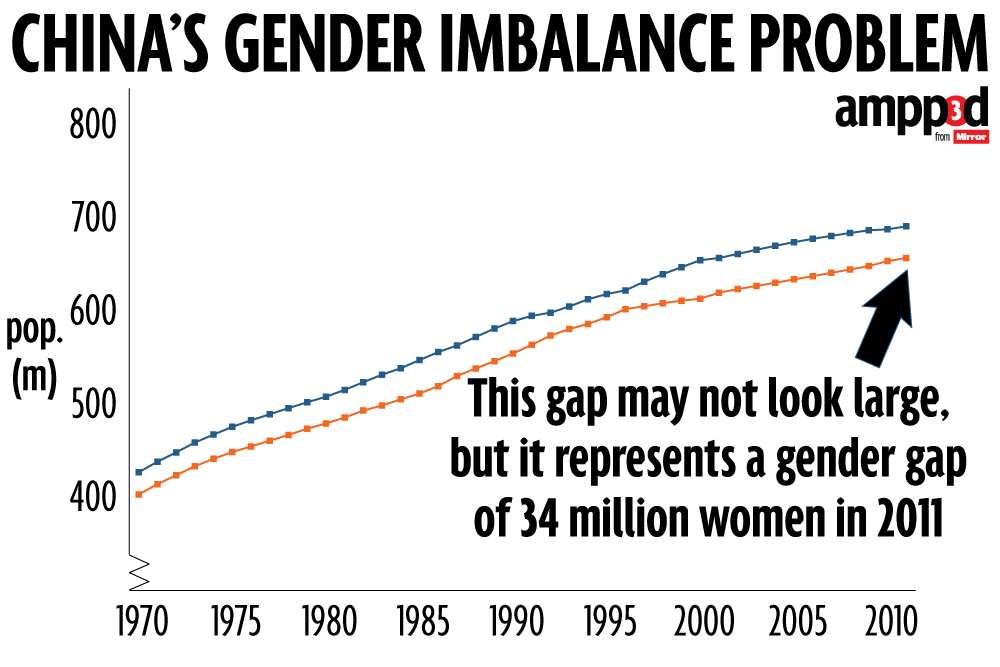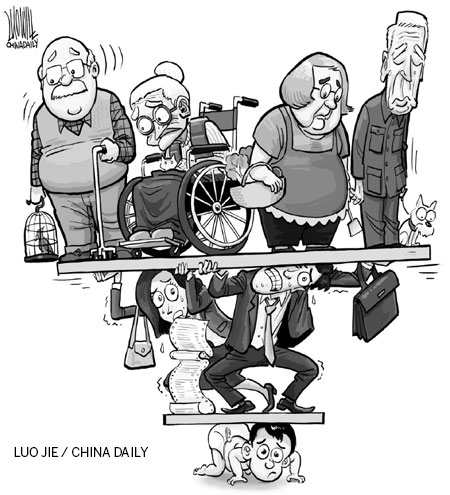China's one child policy
Overview
In 1979, China introduced an Anti-Natalist policy; a one-child policy. This policy implements that couples in China would only be allowed to have one child. The Chinese government created this policy in order to decrease China’s birth rate and slow the population's growth rate.The policy was implemented because in 1950 the population rate was 1.9% per year, which would cause the population to double in approximately 20 years[1]. In the 1950’s, the Chinese government encouraged families to have many children to expand workforce. However, by 1979, the country’s population growth rate grew out of control, and this is the reason why the government decided to take action and create the controversial One-Child policy. There were some exceptions to this policy which made it fair to everyone. For instance, couples whose first child was born handicapped could have a second child. Moreover, couples within an ethnic minority could have a second child if their first born was a girl. People living in rural areas have been harder to control due to their tradition of having large families. Rural areas have approximately 70% of the Chinese people, thus families in rural areas are allowed to have 2 children, only if they are born 5 years apart from each other [2]. Lastly, the exceptions also include parents who work in high-risk jobs, such as mining.
 Chinese family with their only child
Chinese family with their only child
Methods of enforcement
The government has created various methods of enforcement in order to help people in following the law. Many contraceptive methods are available throughout the country, mostly in urban areas where couples there would follow this policy more strictly. Rural areas are tougher to enforce due to the fact that they have and follow traditions for having large families. In order to enforce the whole public, the government has to encourage them by giving them something advantageous in return. For instance, financial benefits are given to those that follow the policy. These benefits can include incentives such as additional employment opportunities. Moreover, couples that follow this policy obtained a certificate stating that they have one child. This particular certificate comes with many benefits which can include an extended maternity leave, and subsidies for housing and education. Fines were given to the people that violated this law, possibly by firing them from their jobs and not giving them any potential benefits. Fines can also include confiscation of certain personal belongings. Although, in the early 1980s punishments began to occur when couples started breaking the law. Women who broke the law were forced to have abortions and forced to become sterile. Sun Mingmei, a Chinese woman decided to have an abortion because she would have to pay a fine of approximately $31,250 [3].
Impacts
Results: After this policy was implemented, the population growth rate is now 0.7%. Since 1979, China has prevented 400 million births. In the 1990s, the fertility rate decreased below 2 children per woman. The sex ratio between men and women was imbalanced and there was approximately 4% more men than women, leaving few women for marriage. The shortage of women has caused an increase in kidnapping women for marriage. The reason for the preference for boys is due to the fact that boys can keep the family name and property, while being the one in charge of their senior parents. This preference was particularly followed in many rural areas, thus making the idea of having a baby girl very unfavorable. The result of this situation showed that tens of thousands of girls were given up for adoption in foreign families.
Birth tourism: Birth tourism is an ongoing problem in China where many mainland Chinese women are traveling abroad to give birth to their second child. For instance, many are traveling to Hong Kong,which does not follow the one child policy, to give birth. However, the government in Hong Kong has increased the price of births for non-local pregnant women in certain hospitals. Approximately 32,000 mainland babies were born in Hong Kong in 2010, which is 40% of the births. Mothers want to give birth in Hong Kong because of the automatic residency and 12 years of free education that their babies would receive [4]. This problem has been occurring internationally as well. In Southern Carolina, immigration and customs enforcement raided “birth tourism” centers that helped Chinese expectant mothers to give birth to their second child in the U.S to obtaining an automatic U.S. citizenship. According to federal investigators, these centers help Chinese women in obtaining tourist visas and then give them accommodation until they give birth. These women pay birth tourism companies approximately $50,000 to give birth in the United States. According to Chinese mothers, this money may seem a lot at first but it's worth it in the long run [5].
Improved lifestyle: With this policy, more jobs, food, and housing space have become available. This has created a more comfortable lifestyle as there is enough space for the population to have achieve a better lifestyle. This policy has improved the poverty rate as it has started to decline throughout the years. Since families are now small, couples can now afford to pay for their child's needs as well as their own. Women's quality of life has also improved since women can now obtain an education and have support for better jobs. Parents who have a girl as their only child start to lose the idea that only boys can obtain an education, thus parents now do anything for their daughters in order to obtain equal rights as boys. In China, women have always had a lower status than men. Parents who have a daughter, no longer have to debate if they should spend money for university for their son or their daughter. Therefore, girls have a better opportunity in achieving a higher education and independence.
Problems

Forced abortions: Women that have become pregnant after their first child are forced to abort their babies and forced to become sterile. China’s Health Ministry claims that since 2000, abortions have been approximately 7 million per year. Feng Jianmei is a Chinese woman whose story sparked outrage across the world. She was forced to have an abortion during her 7th month pregnancy. Her husband could not pay the fine of $6300. Another tragic story comes from “Mrs. Dong” who was 9 months pregnant with twins. She was found by the local family planning office and was forcibly taken to the health center without any legal agreement. About 10 people injected Ethacridine Lactate to abort her babies, and unfortunately they did not make it.
Increased dependency: There is an increasing amount of elderly people who depend on the very little working age population. Thus China could have an ageing population in the future due to its falling birth rate. Approximately 19 million elderly people live alone in the country, with the number doubling by 2050. Most of these elderly people do not have pensions or any form of healthcare, thus the government has brought healthcare to rural areas. Moreover, beds in nursing homes have tripled over the last 5 years.
Undocumented children: Couples who had second children and hid them from authorities were undocumented which made it very difficult for them to obtain an education or jobs. Every Chinese citizen is entitled to a household registration document called “hukou”. Undocumented children without the hukou cannot obtain a passport, a job, a bank account, a national identification card, healthcare, renting an apartment or even public transportation. In 2010, approximately 13 million children were undocumented in China. In the summer of 2014, farmer Wang Guandrong was unable to pay the fines for his 3 children and had his livestock confiscated. The government required him and his wife to pay the fines of his 3 children before they were to be admitted to school. Wang felt trapped and took his own life so that the government would feel guilty and allow his children to be admitted to school [6].
Distorted gender balance: The ratio of men is higher than women, with 116 boys to 100 girls born. Men outnumber women by more than 60 million. Many families do not want to have baby girls because girls have "lower status" than boys. Many baby girls have been killed or abandoned because of this preference. In 2000, 90% of female fetuses were aborted in China. Ultrasound scans which can identify the gender of a baby costs $12 in China. This activity is illegal, however the consequences are light and so many people do it. Suining city has people paying $150 to ultrasound specialists in order to tell them the gender of their baby [7].
Damaging results on the child: Parents give all their attention to their only child, which causes the child to feel like a "Little Emperor", as they are given anything they want without working for it. Children have become spoiled and lazy. Parents satisfy and serve their child's needs, thus they become overweight. Therefore, obesity in China has become a big problem. Moreover, children have become very stressed as their parents have high expectations for their only child. The suicide rates in China have been increasing rapidly due to the stress of being an only child. Children take a major responsibility for their parents when they become old. This is due to the fact that children have to take care of their parents and grandparents, which leads to the child unable to care for themselves.

Eradication
The policy was relaxed in 2013, with couples being allowed to have 2 children if their first child was a girl. However, towards the end of 2015, the Chinese government stated that this policy will come to an end by 2016 and everyone will be allowed to have up to 2 children. This policy needed to come to an end because in approximately 15 years, China could have had the most ageing population in the world. Even though, the policy now allowed 2 children, there are still many controversies about the basic human rights and women being able to choose freely how many children they can have [8].

References
1) BBC 2014. "Managing population change". http://www.bbc.co.uk/schools/gcsebitesize/geography/population/managing_population_rev3.shtml
2) Lu, Shen. "China's One-child Policy Goes but Heartache Remains." CNN. N.p., 1 Jan. 2016. Web. 1 Aug. 2016. <http://edition.cnn.com/2015/12/31/asia/china-second-child-policy-in-effect/>
3)Simpson, Peter. "Chinese 'birth Tourists' to Hong Kong Double." The Telegraph. Telegraph Media Group, 9 Feb. 2012. Web. 02 Aug. 2016. <http://www.telegraph.co.uk/news/worldnews/asia/hongkong/9072457/Chinese-birth-tourists-to-Hong-Kong-double.html>
4)"Gender Imbalance in China." Gender Imbalance in China | All Girls Allowed. All Girls Allowed, 2013. Web. 02 Aug. 2016. <http://www.allgirlsallowed.org/gender-imbalance-china-statistics>
5)Ertelt, Steven. "Chinese Twins Aborted at 9 Months Due to One Child Policy | LifeNews.com." LifeNews.com. Life News, 23 Sept. 2014. Web. 02 Aug. 2016. <http://www.lifenews.com/2014/09/23/chinese-twins-aborted-at-9-months-due-to-one-child-policy/>.
6)Plaster, Genevieve. "13 Million Undocumented Children Who Can’t Attend School." LifeNews.com. Life News, 1 Apr. 2015. Web. 1 Aug. 2016. <http://www.lifenews.com/2015/04/01/chinas-one-child-policy-creates-13-million-undocumented-children-who-cant-attend-school>
7)Buckley, Chris. "China Ends One-Child Policy." The New York Times. The New York Times, 29 Oct. 2015. Web. 02 Aug. 2016. <http://www.nytimes.com/2015/10/30/world/asia/china-end-one-child-policy.html>
By: Maria Aramayo
- ↑ http://www.bbc.co.uk/schools/gcsebitesize/geography/population/managing_population_rev3.shtml
- ↑ https://www.britannica.com/topic/one-child-policy
- ↑ http://edition.cnn.com/2015/12/31/asia/china-second-child-policy-in-effect/
- ↑ http://www.telegraph.co.uk/news/worldnews/asia/hongkong/9072457/Chinese-birth-tourists-to-Hong-Kong-double.html
- ↑ http://www.voanews.com/content/activists-say-china/2668426.html
- ↑ http://www.lifenews.com/2015/04/01/chinas-one-child-policy-creates-13-million-undocumented-children-who-cant-attend-school
- ↑ http://www.allgirlsallowed.org/gender-imbalance-china-statistics
- ↑ http://www.nytimes.com/2015/10/30/world/asia/china-end-one-child-policy.html